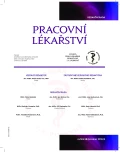Exogenous allergic alveolitis „hot tub lung“
Authors:
H. Bejčková
Authors place of work:
Klinika pracovního lékařství FN a LF UK Plzeň
přednostka MUDr. Vendulka Machartová, Ph. D.
Published in the journal:
Pracov. Lék., 68, 2016, No. 4, s. 137-140.
Category:
Kazuistika
Summary
Exogenous allergic alveolitis (EAA) is a granulomatous inflammatory lung disease caused by inhalation of antigenic organic particles or dusts. The most frequently causing agents include moldy hay and straw, bird secretion and feather, contaminated wood dust, moldy cheese, decaying malt, barley or sugar cane, air conditioning, rodent skin, plastic matters, paint hardeners – isocyanates, insecticides, metal fluids, peat, compost, mold from Japanese households, soya beans in animal feed, dust in mushroom processing, cork oak bark, mold infected wheat, but also hot baths. With the gradual spreading of relaxation baths we can anticipate spearing of diseases of exogenous allergic alveolitis (sc. hot tub lung) not only in people indulging in hot tubs with hot water, but with insufficient care of regular disinfection also in the personnel. A case on non-occupational disease is described, but the same disease can develop as on occupational disease as well. We describe the case of a woman aged 36 years when she encountered the disease. She moved with her family to a recently built house, where a Whirlpool whirling bath was placed in the living room. After less than two months she encountered breathing problems, febricity, and blending blurred areas on lung X-ray pictures. Lung CT was at first concluded as very suspect acute sarcoidosis, but the control examination already indicated exogenous allergic alveolitis. Breathing problems occurred in her two sons as well and a thorough examination during hospitalization was concluded by establishing diagnosis of exogenous allergic alveolitis. The treatment with corticoids and removal of the whirling tub from the living room resulted in complete disappearance of the symptoms in the patient and also in her sons and the X-ray picture improved as well.
KEYWORDS:
exogenous allergic alveolitis – hot tub lung
Zdroje
1. Aksamit, T. R. Hot tub lung: infection, inflammation, or both? Semin. Respir. Infect., 2003, 18, s. 33–39.
2. Fjälbrant, H., Akerströmem, M., Svenson, E., Anderson, E. Hot tub lung: an occupational hazard. Evropská respirační review 2013, 22, s. 88–90.
3. Kolektiv autorů. Pracovní lékařství. Základy primární pracovnělékařské péče. NCO NZO Brno 2005, XVI. 3. 9., s. 278–280.
4. Kongres American College of Chest Physicians „Chest 2004“ Seattle, USA, 23.–28. října 2004.
5. Machartová, V. et al. Pracovní lékařství pro lékaře všech odborností. CZ.1.07/3.2.02/01.0026. 2013, s. 40–48.
6. Pelclová, D., Lebedová, J., Fenclová, Z., Lukáš, E. Nemoci z povolání a intoxikace. Praha: Nakladatelství Karolinum 2002, ISBN 80-246-0433-7.
7. Šterclová, M. Exogenní alergická alveolitida – navrhovaný doporučený postup pro diagnózu, léčbu a sledování. Sekce intersticiálních plicních procesů České pneumologické a ftizeologické společnosti. Interní Med., 2012, 14, 10, s. 383–386.
8. Tichý, T., Musilová, K., Škarda, J. Morfologie granulomů a základní histologie vybraných plicních granulomatóz. Sympozium Sarkoidóza a jiné granulomatózy. Regionální centrum Olomouc, 17. října 2008.
9. Vašáková, M. Co hrozí milovníkům parních lázní, bazénů a vířivek? Plíce horkých koupelí aneb „hot tub lung“. Kazuistiky v pneumologii 2, č. 2, 18, 2005.
10. Verma, G., Jamieson, F., Chedore, P. et al. Hot tub lung mimicking classic acute and chronic hypersenzitivity. Can. Respir. J., 2007, 14, s. 354–356.
11. Waninger, K. N. Is it on your list of respirátory ailments? J. Fam. Pract., 2006, 55, 8, s. 694–696.
Štítky
Hygiena a epidemiológia Hyperbarická medicína Pracovné lekárstvoČlánok vyšiel v časopise
Pracovní lékařství

2016 Číslo 4
- Parazitičtí červi v terapii Crohnovy choroby a dalších zánětlivých autoimunitních onemocnění
- V ČR chybí specializovaná péče o pacienty s nervosvalovým onemocněním
Najčítanejšie v tomto čísle
- Exogenní alergická alveolitida „hot tub lung“
- Profesionálna astma – choroba z povolania s neistou prognózou
- Diagnóza: sanitář
- Klíšťová encefalitida jako nemoc z povolání – kazuistika
